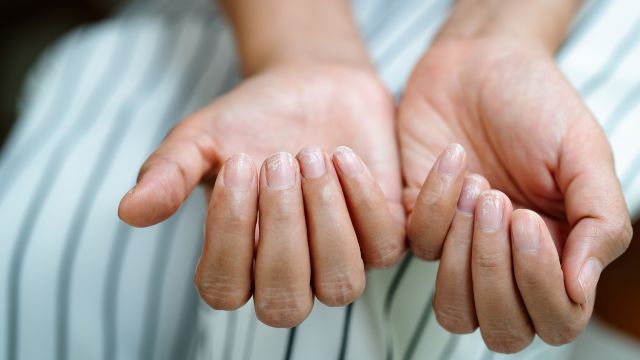Psoriatic arthritis (PsA) can be hard on your hands and feet. Many people with PsA experience pain and swelling in their fingers and/or toes, which can make it difficult to perform basic everyday tasks like writing or walking. There are also the changes to the appearance and texture of the nails, which can be painful and also make you feel stigmatized. Check out these five at-home tips to treat common psoriatic arthritis hand and foot woes.
Stay on top of your nail care
According to the National Psoriasis Foundation (NPF), 86 percent of people with psoriatic arthritis also have nail psoriasis, which can lead to pitting, discoloration, thickening, ridging and separation from the nail bed. For those with mild symptoms, topical treatments or steroid injections may be an effective route.
It’s important to sleuth out where your nail changes are coming from. While nail problems may be due to the psoriasis itself, one-third of nail issues actually stem from a fungal infection, in which case completely different treatment is needed. Talk to your healthcare provider (HCP) to see what treatment is appropriate for you.
Protect your nails
Injuries to the nails can trigger nail psoriasis, or cause symptoms to flare. Also, certain medications for psoriatic arthritis can make your nails more vulnerable to infection. To protect them, wear gloves when working with your hands, keep your nails clean and short (but not too short) and beware of acrylic nails, which can weaken nail beds. Practice safe cuticle care by using gentle techniques such as buffing. While painting your nails may help hide the appearance, you may want to steer clear of polish until talking to your HCP, as polish may affect your symptoms.
Wear comfortable footwear
You'll want to choose breathable footwear that offer your toes some wiggle room—and you'll want to avoid high heels and tight-fitting shoes that leave your feet cramped. Choose shoes that have arch support and some sort of cushion, especially if you have pain in the soles of your feet, a common problem in PsA. Pick the right material to prevent fungal infections. Leather and canvas are good options for shoes, while synthetic materials for socks can help wick away moisture. Also pick the right footwear for the occasion—for example, closed-toe shoes when you're doing an activity where there's a risk of stubbing your toes or dropping something on your foot.
Try some cold therapy
If psoriatic arthritis is causing your hands and/or feet to ache, you may want to apply some cold packs to lessen throbbing. For a DIY cold pack, grab a bag of veggies or put some ice in a Ziploc bag. Use a barrier (like a small towel) when applying to avoid irritating swollen fingers and potentially inflicting an ice burn. For best results, trade off every 10 minutes—apply the ice pack for 10 minutes, then break for another 10 minutes.
Don’t soak up too many suds
A long bubble bath may seem like the soothing answer to your psoriasis woes, but soaking in the tub for too long can actually suck the moisture out of your skin and worsen your symptoms.
While all these tips are helpful, the best way to soothe your achy hands and feet is ensure that you’re doing all you can to manage your PsA. Talk to your HCP about all your symptoms and stick with your treatment plan.





